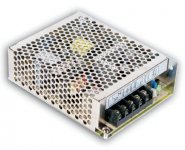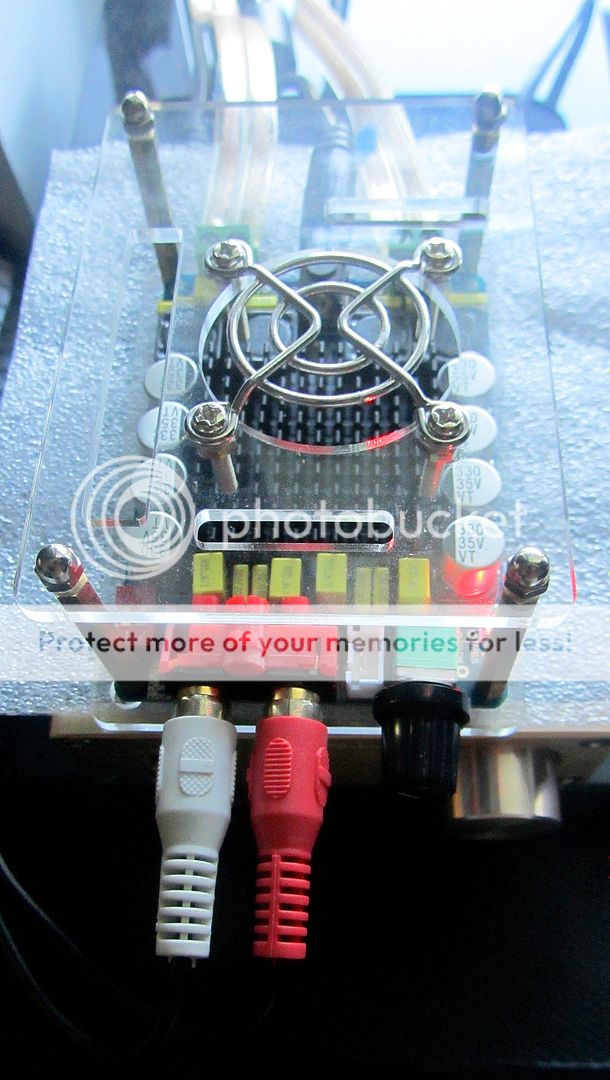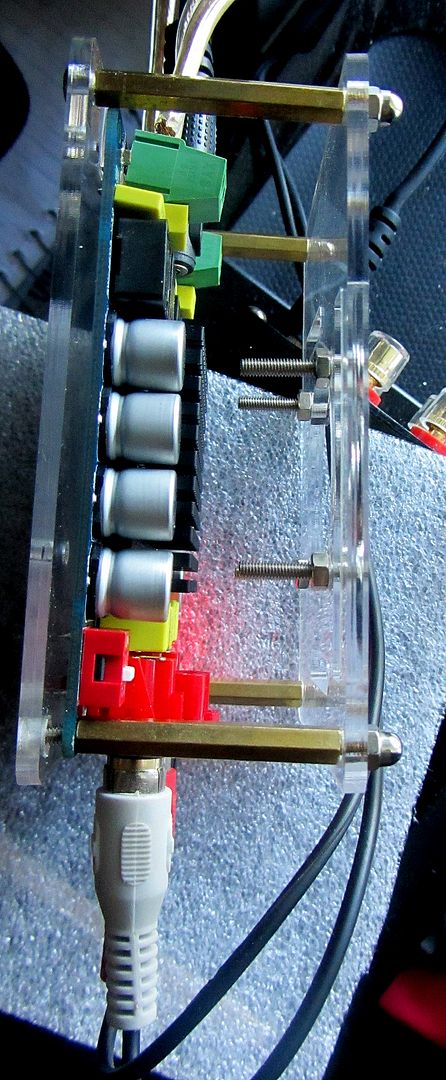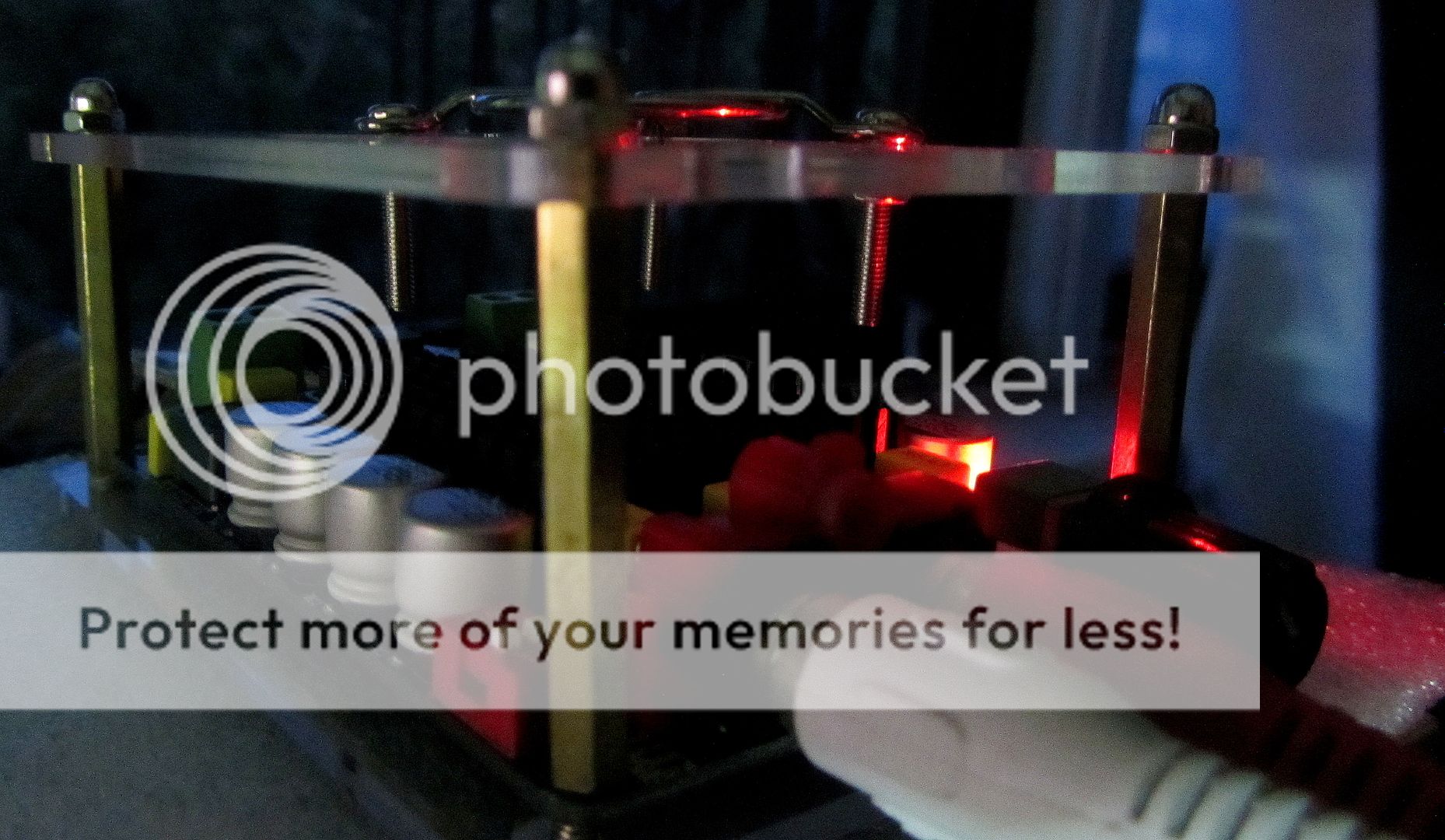Check the measurements before ordering 😉
Fan probably isn't necessary, which is good, because it wouldn't do to well with the amp's supply voltage.
My basic Sanwu board came a couple of days ago in record time (~7 days). I spent an excessive amount of time making up a test harness. It would have been faster putting it in a case, but I can reuse the hookups with other boards.
I'll need to do some side-by side testing with other amps. It sounds good, maybe a little brighter than I'm used to, and the bass seems to have more kick, but both impressions may just be the result of listening at louder-than usual levels.
The old $5, 32v 2.5A HP printer power brick I picked up has been great. It may not be able to deliver enough power to use all of the amp's clean-power range, but it's got enough to be too-loud for my desktop setup.
Yep gonna try it without the fan. I just need a small drill bit. Which I think I have. Man that was fast mine took 2 weeks! Glad the 2.5 amp worked out. You gonna build a box?
Talk about on and off switches. I got the ac plug one locally today for $1.73. It turns on the internet and the amp at the same time. 🙂
Same one: https://www.amazon.com/QVS-PA-1P-Si...73525222&sr=8-2&keywords=ac+on+and+off+switch
Same one: https://www.amazon.com/QVS-PA-1P-Si...73525222&sr=8-2&keywords=ac+on+and+off+switch
Those are cool
Nice, and they take up much less space than a power strip. Good find!
Mark
Talk about on and off switches. I got the ac plug one locally today for $1.73. It turns on the internet and the amp at the same time. 🙂
Same one: https://www.amazon.com/QVS-PA-1P-Si...73525222&sr=8-2&keywords=ac+on+and+off+switch
Nice, and they take up much less space than a power strip. Good find!
Mark
Yes, but...
I have no doubt about your statement. But, the fact is, I own a bunch of chip/class D amps with power switches on the DC side.
No matter. It seems people are clueless about the cause of the situation so I will proceed on my own.
Thanks,
Mark
It is always better to switch the AC side than DC. Less detrimental to the switch.
I have no doubt about your statement. But, the fact is, I own a bunch of chip/class D amps with power switches on the DC side.
No matter. It seems people are clueless about the cause of the situation so I will proceed on my own.
Thanks,
Mark
All things being equal, the inrush current with a 30v supply will be higher than with a 24v supply. Beefier switch? I just wired up a board and decided to use a dual-pole switch in parallel to distribute the load.
The blobs on the cords are ferrite beads to cut radiated RF and reduce electromagnetic interference.
The blobs on the cords are ferrite beads to cut radiated RF and reduce electromagnetic interference.
Yep gonna try it without the fan. I just need a small drill bit. Which I think I have. Man that was fast mine took 2 weeks! Glad the 2.5 amp worked out. You gonna build a box?
Yeah, that's the fastest I've received anything from HK/China by at least 3 days.
I don't know what I'm going to do with the board yet. I kind of like the aesthetics of these Sanwu boards. I have two of the orange TPA3116 modules that I'm experimenting with for a 2.1 setup and I plan to have them both exposed somehow.
I forgot to mention a few things about the Sanwu TDA7498 board.
It is quite small, roughly, if not exactly, the size of the red/orange Sanwu TPA3116 boards -- the size of a playing card.
Powered with 32v using the default gain setting, the inductors are about 64c, and the heatsink is about 55c, with or without an input signal. With 24v, those numbers drop to 46c and 41c.
With no signal and the input connected through a 20k linear pot with a 2.5k resistor on the wiper (a-la ESP "better volume control" it's hard to detect if its powered on or off. Noise is very low with power applied. When switching the power on there is only a very faint click through the speakers.
It seems people are clueless about the cause of the situation so I will proceed on my own.
A but unfair...
I told you what cause this...
The in rush (spell? ) current is a burst of high energy, just like a thunder. Beef but powerful.
That is caused by capacitors capability to deliver high currents - that's good.
Want to reduce it? Place an inductor in the way or do as someone already suggested, place the switch in AC side.
Jopereira and easp
No, I didn't mean it that way (mean or snarky). Still, to think three different brands of switches, all rated at 6 amps are to blame, especially when these same switches have worked without fail on many projects in the past, seems to me at least unlikely.
That said, I will apologize and bow to your expertise, sir! Much of this is way over my head. Electronics is interesting to me but I'll be the first one to admit I don't have a natural talent for it.
As previously state, I've switched to the 24 VDC supply with no apparent sonic differences. So all is good.
Easp, don't those CL60/CL90 devices help with inrush current? I have some of those (one or the other, not sure if CL60 or CL90) in a parts box. Someone gave them to me once but I don't know how they wire up or really much about them.
Would those be worth a try?
Thanks to both of you gentlemen,
Mark
No, I didn't mean it that way (mean or snarky). Still, to think three different brands of switches, all rated at 6 amps are to blame, especially when these same switches have worked without fail on many projects in the past, seems to me at least unlikely.
That said, I will apologize and bow to your expertise, sir! Much of this is way over my head. Electronics is interesting to me but I'll be the first one to admit I don't have a natural talent for it.
As previously state, I've switched to the 24 VDC supply with no apparent sonic differences. So all is good.
Easp, don't those CL60/CL90 devices help with inrush current? I have some of those (one or the other, not sure if CL60 or CL90) in a parts box. Someone gave them to me once but I don't know how they wire up or really much about them.
Would those be worth a try?
Thanks to both of you gentlemen,
Mark
Mark, yes, the CL60/CL90 (and others) are intended for inrush current limiting. I'm not yet acquainted with their proper application.
I stuck some heatsinks on the inductors of my Sanwu TDA7498, apparently I need bigger ones. The inductors are still ~62C and are definitely warming up the electrolytic caps to 50C -- they are 105C-rated caps, but I'd rather have more headroom.
I stuck some heatsinks on the inductors of my Sanwu TDA7498, apparently I need bigger ones. The inductors are still ~62C and are definitely warming up the electrolytic caps to 50C -- they are 105C-rated caps, but I'd rather have more headroom.
Switching DC is a detrimental approach as switches will burn in. This is a known fact (common knowledge even), it is just that this news from some decades ago has not arrived yet in china. It possibly has something to do with the fact that many devices are intended to be used with a leftover separate power brick that lacks a switch as 230V 10 A rated switches are simply too expensive on cheap gear. Same counts for those imbecile round 5.5 mm DC connectors with various pin sizes that spark when connected. This while screw connectors are way more safe and durable and they avoid sparks and plugging in devices when powered on. One should switch AC no matter how many devices in this world are configured with errors. In the "world of cheap" this power brick/round DC connector combo has become some kind of a standard that works for a while and boards are thus somewhat interchangeable as the intention is that we buy at least 100 boards in our lifetime 😉 User (un?)friendliness, just give it a name. It is not the approach people who go by solid engineering would choose.
Yes, switching DC works, why wouldn't it ? Yes it works for some time too. Nevertheless the switch will burn in and will be higher in resistance than it should be after switching many cycles (or not so many depending on the situation).
Best would be to encase cheap boards on a aluminium sheet, or subchassis, mounted with isolated standoffs on the metal chassis and to use an "open" PSU (connected to PE just like the case) with a 230V 10A rated switch at the primary side (mains) really switching a device off when you want it to be switched off. When new boards arrive one only needs to cut a new aluminium sheet and drill the appropriate mounting holes for the new boards... This works perfectly. Many boards offer a muting feature only putting the device in standby just to avoid costs of a good real mechanical 230V 10A rated switch... You know, that part that will not be available anymore within a few years.
Yes, switching DC works, why wouldn't it ? Yes it works for some time too. Nevertheless the switch will burn in and will be higher in resistance than it should be after switching many cycles (or not so many depending on the situation).
Best would be to encase cheap boards on a aluminium sheet, or subchassis, mounted with isolated standoffs on the metal chassis and to use an "open" PSU (connected to PE just like the case) with a 230V 10A rated switch at the primary side (mains) really switching a device off when you want it to be switched off. When new boards arrive one only needs to cut a new aluminium sheet and drill the appropriate mounting holes for the new boards... This works perfectly. Many boards offer a muting feature only putting the device in standby just to avoid costs of a good real mechanical 230V 10A rated switch... You know, that part that will not be available anymore within a few years.
Last edited:
When new boards arrive one only needs to cut a new aluminium sheet and drill the appropriate mounting holes for the new boards...
Or you drill the appropriate mounting holes for the new boards in the existing subchassis/aluminium sheet ... and be done with it. Working this way will ensure your case will be without too much unnecessary marks, dents, scratches and excess holes.
Last edited:
Excuse me for the slightly cynical tone. I attached a picture what I mean with "open" PSU. Please note that the case and the PSU should be connected to PE but the subchassis and all connectors (except for the PE connection of the mains connector !!) should be floating. No ground loops this way and your device will be safe of everyone that uses it. As usual I mention that UK electro fundamentalists also want to connect any metal part to PE but I don't do that as I don't like ground loops and hum. In general I keep audio GND and PE separated but with the power amp I "lift" the audio GND to PE (all other devices will be connected to audio GND by their RCA plugs GND).
I also attached a picture of a certain 230V 10A switch. My experience is that I build devices and after some time I can not obtain the type of switch that I used last time anymore. Now I stick with one reliable type and buy a few of them while they are still available. This way a new DAC or any other device will have the same look and feel as for instance the preamp.
Technically a good way of working but it needs experience and know how to safely connect stuff to mains. If one is uncertain how to do this please keep to the power brick/round DC connector system and enjoy the sparks 😉
I also attached a picture of a certain 230V 10A switch. My experience is that I build devices and after some time I can not obtain the type of switch that I used last time anymore. Now I stick with one reliable type and buy a few of them while they are still available. This way a new DAC or any other device will have the same look and feel as for instance the preamp.
Technically a good way of working but it needs experience and know how to safely connect stuff to mains. If one is uncertain how to do this please keep to the power brick/round DC connector system and enjoy the sparks 😉
Attachments
Last edited:
Yes!
Hi Jean-Paul,
Yes, I use those same type of power supplies. In fact, the 24vdc one I'm using now is an open cage, Meanwell type clone.
And, I just got some round switches like the one you show. I used those in the past, but got mildly frustrated that none of my Forstner drill bits quite worked and I had to sand or rasp the nearest sized hole to make the switch fit. (I work exclusively with wooden enclosures I build myself; not metal ones.) So, I haven't been using the round ones the past several years.
But recently, I bought a 20mm Forster from China on eBay which is surprisingly good. It cuts very cleanly. The fit is perfect. And it was ridiculously inexpensive as well. So, I can now get back to those round switches and eschew the mini toggle types that seem a lot more fussy and prone to failure.
Thanks for the guidance. Appreciated greatly!
Mark
Hi Jean-Paul,
Yes, I use those same type of power supplies. In fact, the 24vdc one I'm using now is an open cage, Meanwell type clone.
And, I just got some round switches like the one you show. I used those in the past, but got mildly frustrated that none of my Forstner drill bits quite worked and I had to sand or rasp the nearest sized hole to make the switch fit. (I work exclusively with wooden enclosures I build myself; not metal ones.) So, I haven't been using the round ones the past several years.
But recently, I bought a 20mm Forster from China on eBay which is surprisingly good. It cuts very cleanly. The fit is perfect. And it was ridiculously inexpensive as well. So, I can now get back to those round switches and eschew the mini toggle types that seem a lot more fussy and prone to failure.
Thanks for the guidance. Appreciated greatly!
Mark
I got a ~1KG package yesterday with my order of boards from Sanwu's Taobao. Among them, one of the deluxe TDA7498 boards like the one Afterlife2 is using above.
Some quick notes:
I think I've found the board to recommend to people when they are after a cheap amp. Decent sound without mods, and no need to add a pot, an input jack, or a power jack. Reasonable layout for slipping into an enclosure without a lot of fuss, and a connector if you want to use a different means of input. Filter caps are through-hole if you want to fit something to better match your speakers.
As to the smaller Sanwu board, it's output filter caps are also through-hole. Unfortunately, I think the Sanyo bulk-electrolytic caps are counterfeit. They have a cross-shaped vent, rather than the K shape used by authentic Sanyo caps (the orange-red Sanwu TPA3116 boards I have have similar looking "Sanyo" caps. Or have things changed since Sanyo was bought by Panasonic? Are panasonic still shipping Sanyo branded caps?
Some quick notes:
- Lots more polyester box caps on both the input and output compared to the small Sanwu TDA7498 board I have.
- On the inputs, the smaller board has two 1uF box caps (one per channel) and it looks like there are more ceramics under the heatsink. The deluxe board has four 1uF box caps (2/channel) and another four 10nF (2/channel), along with a few ceramics under the heatsink. I haven't tried tracing out how any of them are connected.
- On the outputs, the smaller board has two 470nF box caps (1/channel) along with 8 SMD ceramics (4/channel) (also 2-resistors/channel). The deluxe board has two 470nf box caps, four 220nf box caps (2/channel) and 4 ceramics (2 channel)
- Both boards seem to use the same value (22uH) and make of inductors in the output filter, but they run much cooler on the deluxe board (both with 32v power) ~53C vs 64C. The main heatsink is also cooler: 50c vs 54c. The board is a little larger and less crowded around the inductors, but I doubt that explains most of the difference.
- Both boards are quiet/silent on power-up.
- With the volume pot on full and connected to an idle AirportExpress, noise on the deluxe board is barely detectable in the lowest gain setting. The noise is perceptibly louder on the next gain level, but only just. It's more obvious in the top two gain settings, but still difficult to pickup unless you are a foot or two from the speaker.
- The RCA connectors on the deluxe board are kind of crummy. I had similar plugs on finished TDA7492 amp I bought, until I replaced them with some panel-mount jacks. The crummy connectors actually work better with cheap stamped sheetmetal plugs than they do with more expensive machined plugs.
I think I've found the board to recommend to people when they are after a cheap amp. Decent sound without mods, and no need to add a pot, an input jack, or a power jack. Reasonable layout for slipping into an enclosure without a lot of fuss, and a connector if you want to use a different means of input. Filter caps are through-hole if you want to fit something to better match your speakers.
As to the smaller Sanwu board, it's output filter caps are also through-hole. Unfortunately, I think the Sanyo bulk-electrolytic caps are counterfeit. They have a cross-shaped vent, rather than the K shape used by authentic Sanyo caps (the orange-red Sanwu TPA3116 boards I have have similar looking "Sanyo" caps. Or have things changed since Sanyo was bought by Panasonic? Are panasonic still shipping Sanyo branded caps?
From I believe April 2009 the Sanyo electrolytics are sold under Suncon name, produced at same place as before, identical, just no longer Sanyo name on foil. Panasonic doesn't use Sanyo name on capacitors, hardly on anything else either btw.
does anyone here also have the small 2,63$ TDA8932 board from ebay for a comparison? I would like to know how does this TDA7498 compare to it especially in the bass department? thanks
So I just bought a board the same as shown on afterlife's photos. I'm using an old dell laptop power supply (19V, 4A). I've noticed a high pitched whine on my speakers even when the volume pot is only half way turned up. Is this normal?
Last edited:
- Status
- Not open for further replies.
- Home
- Amplifiers
- Class D
- Ebay cheap TDA7498 boards





